On Wednesday Claudia and I rose early and drove down to the San Joaquin Valley. We spent most of the day photographing birds with our friends G Dan Mitchell, Patty Mitchell, David Hoffman, and Charlotte Hoffman, and had a wonderful time. The human company was great, and we found lots of my favorite bird subjects – the white Ross’s and snow geese.
While composition and light are always vital, some aspects of wildlife photography are very different from landscape photography. With wildlife the subjects are moving, placing greater importance on anticipation, timing, and the ability to make quick decisions about framing and camera settings.
With moving subjects, one of the most important camera settings is, of course, the shutter speed. Fast shutter speeds are great for showing patterns and details, like in the photograph above. That was taken at 1/250th sec., which wasn’t quite fast enough to freeze the wingtips, but I don’t mind that, as that little bit of blur helps to convey some sense of motion. But if you want to completely freeze the movement of geese you need 1/500th sec. or faster. And smaller birds have quicker wingbeats, which require even faster shutter speeds.
Using slower shutter speeds is more difficult. You have to pan smoothly at just the right speed to keep some of the birds relatively sharp, and hope that the birds and background arrange themselves into a harmonious composition. I end up throwing out many more of these images than I keep. But if everything comes together, the blurring can convey the motion and commotion of these birds better than if the photograph were tack sharp. The slow shutter speeds also create a soft, impressionistic, evocative mood that I like.
I usually use 1/15th sec. for panned images of geese. Faster shutter speeds don’t give enough blur, and with slower speeds it’s difficult to keep any of the birds sharp. I typically hand-hold these (I know, that’s a rarity for me!), and try to turn my shoulders and upper body smoothly as I’m following the birds. Sometimes I’ve used a tripod with an inexpensive video panning head for panning.
Another challenging aspect of wildlife photography is… editing! You have to take a lot of frames to get a few good ones, and it can be hard to sort through them and pick out the best ones. Let me know if you have a favorite from this group.
— Michael Frye
Related Posts: Winter Pilgrimage; Natural Beauty in Motion—Two New Videos
Did you like this article? Click here to subscribe to this blog and get every new post delivered right to your inbox!
Michael Frye is a professional photographer specializing in landscapes and nature. He is the author or principal photographer of The Photographer’s Guide to Yosemite, Yosemite Meditations, Yosemite Meditations for Women, and Digital Landscape Photography: In the Footsteps of Ansel Adams and the Great Masters. He has also written three eBooks: Light & Land: Landscapes in the Digital Darkroom, Exposure for Outdoor Photography, and Landscapes in Lightroom 5: The Essential Step-by-Step Guide. Michael written numerous magazine articles on the art and technique of photography, and his images have been published in over thirty countries around the world. Michael has lived either in or near Yosemite National Park since 1983, currently residing just outside the park in Mariposa, California.

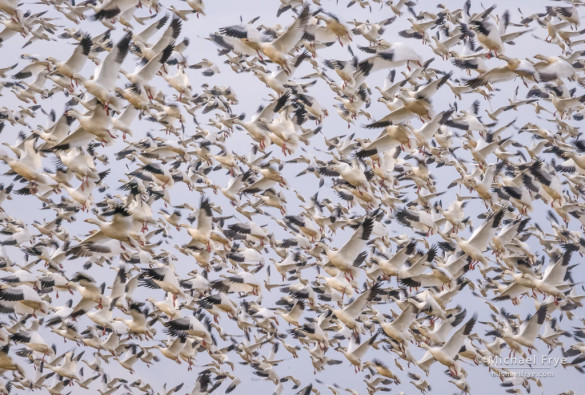
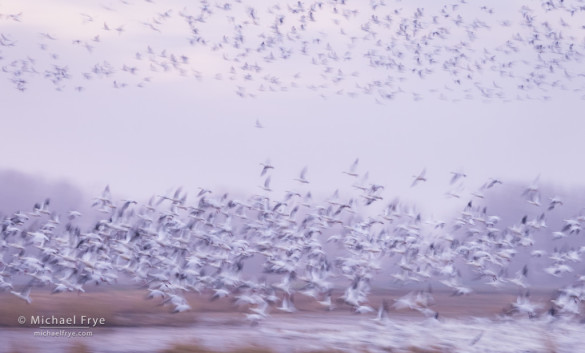
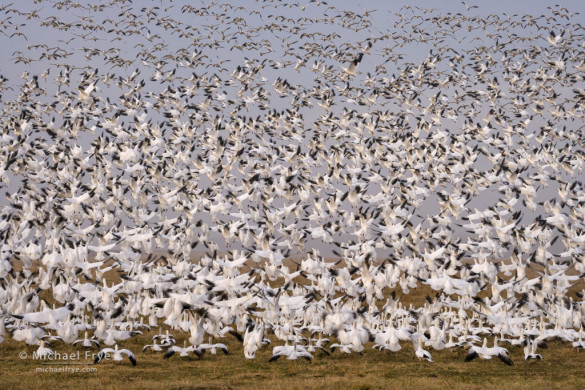
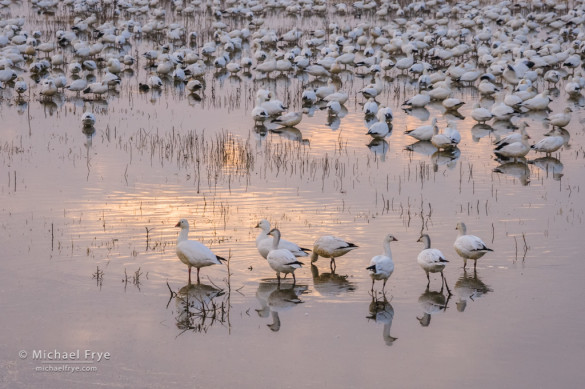
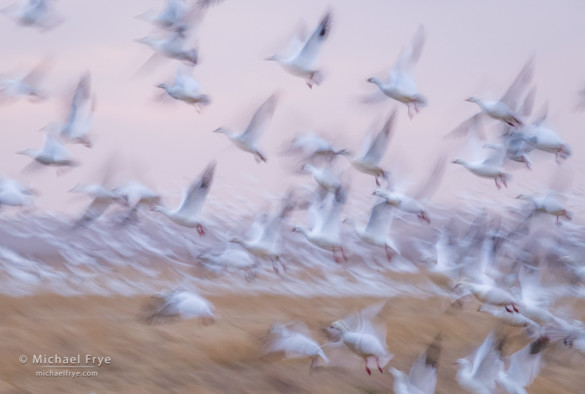
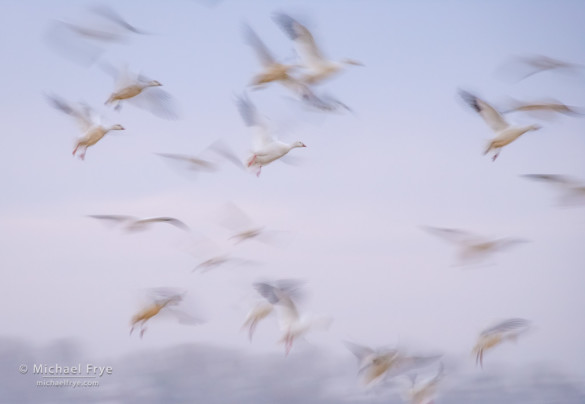








Michael, I really like: Morning fly-out, Ross’s geese, San Joaquin Valley, CA, USA; 1/15th sec. at f/11, ISO 800. I also like: Ross’s geese resting in a marsh, San Joaquin Valley, CA, USA; 1/250th sec. at f/16, ISO 1600, however, it didn’t strike me as germane… I loved the splash of warm golden light contrasting with the overall coolness of the other tones.
Question(s):
1) How many frames did you shoot that day?
2) When you mentioned “an inexpensive video panning head”, I’m assuming you did not mean a gimbal style head. What do you use?
Thanks for letting me know about your favorites Jerry. I captured about 550 frames. No, I didn’t mean a gimbal-style head. It’s an old Manfrotto video head, at least 20 years old. I’m sure it cost me less than $50.
Awesome! I photograph college football and have to make quick decisions with my camera too. I really like the last photo. Great stuff!
Thanks David!
I’ve shot the blast-off at Bosque del Apache in New Mexico. It’s a challenging subject (and I’m not especially happy with the results I got), but it’s sure impressive.
Of the ones you show here, I have a strong preference for “Ross’s Geese Lifting Off”. I think it gets the character of the launch better than the others.
Thanks for chiming in Doug! Bosque is spectacular, though sometimes overrun with photographers. 🙂
Thanksgiving is particularly bad, but between Christmas and New Years, I didn’t see anywhere near as many people. Cold-ish, though. 😎
If you ever find yourself near Roswell, NM at those same times, Bitter Lake NWR can be quite nice, though. Nowhere near as popular and the surrounding topography isn’t as interesting, but it can be quite pretty and it can have quite large populations of Sand Hill Cranes and geese as well.
Plus, the terrain between Bosque del Apache and Roswell is worth the time to make it a loop trip. (White Sands plus two interesting mountain ranges and the Valley of Fires.)
Doug, I haven’t been to Bosque in a while, but I’m glad to hear that there are some quieter times even during the peak winter season. And cold is good — it can create mist rising off the water. 🙂 And thanks for the tip about Bitter Lake.
Love love love Ross’s geese taking flight. I love when photography looks like a painting. VERY beautiful work.
Thank you Liz!
Michael, they are all wonderful but I like “Ross’s geese lifting off” and ” Ross’s geese taking flight” the most simply because they seem more different from what I remember of your geese photographs from the last year or two. Can you say where this is?
Thank you Lenya! Sorry, too many people read this blog for me to post specific locations. I’ve seen places that were virtually unknown become overrun with photographers in a just a few years thanks to the power of the internet.
I understand you perfectly, Michael! It is, indeed, bordering on absurd sometimes.
Very good information about the shutter speeds, Michael. The tech data for the images doesn’t include lens focal length, and I’m wondering how much difference, if any, there would be shooting the 1/15th and 1/250th for a 70-200 zoom vs something like 400mm.
Favorites among the photos: on first impression I went for the slow speed “taking flight”, but when I clicked to look at the larger versions of each image, I liked the lead photo, “formation…taking flight” more. I also like both “resting” and “flyout” with a panorama-like crop for the bottom area, with a format something like a Facebook cover photo.
Thanks Greg. It’s not the focal length that matters as much as the relative motion of the subject across the frame. If a bird is moving across the frame, the relative motion of it’s body is faster than if it’s moving toward you or away from you, though the wing-blur would be about the same in either case. Also, if a bird is larger in the frame it’s relative motion will be greater than if it’s smaller. Obviously a longer lens would tend to make the bird larger in the frame, but if you had some birds close to you, and you used a 100mm lens, and then you had another photograph with the birds farther away, and you used a 400mm lens, but in both cases the birds ended up being the same size in the photograph, and they were moving in the same direction at the same speed, the effect of a 1/15th sec. shutter speed would be identical in both.
Hi,
I love your slow shutter speed images. Very Zen like – soft – quiet,
almost as if you could see the heart that is creating these beautiful images.
Thanks very much Joseph, and very well said.
Great info and really, really beautiful images. I was at (I think) this same location a few weeks ago, and can’t wait to go back–it’s impressive seeing birds like the Ross’s gees and the cranes in great numbers. I also tried for the first time doing some blurred motion images like some of the pics above–and it’s not easy! In addition to getting the right shutter speed down, there’s certainly a knack to coming away with a successful image like that (even if, and especially if, you’re shooting hundreds of frames!). I’m enjoying the challenge of the learning curve, though!
Thanks Robin! I’m glad you had a chance to try some blurred-motion images. It is fun, though definitely challenging.
My favorites are Formation of Ross’s Geese and Ross’s Geese lifting off. I like to look for individual birds in the midst of all the chaos. Thanks for answering the question on focal length as I had the same one. In Ross’s geese landing there is one bird that is almost sharp. If you were going to try to keep one bird sharp and the rest blurred by different speeds and distance, what shutter speed would you use? Is it based on shutter speed alone or a combination of shutter speed and panning. I think it is based on both but I am not sure what shutter speed I should try while panning.
Thank you Chris!
The fact that one bird is sharper than the others in that photo is a lucky accident caused by the birds moving at different speeds. You’ll notice that most of the birds near the top of the frame are sharper than the birds near the bottom, because the bottom ones were closer to the ground and had slowed down more as they came in for a landing. I was probably still panning at a faster speed, closer to the speed of the birds at the top, which is why they look sharper.
You can’t plan and execute a photograph where you hope to get one bird sharp and others blurred, or anything close to that. The best you can do is take a lot of photos, pan smoothly at the right shutter speeds, with the right backgrounds, frame things as best you can on the fly, and hope some of the images work. The exact nature of how they might work is something you can’t control, but in most images like this some birds are sharper than others, because they’re rarely all moving at the same speed relative to the camera position. Personally I think it’s more fun to not be in complete control when making photographs like this, as then you can be surprised by what the camera captures – as I was surprised by the one goose being sharp in that image, surrounded by a nice pattern of fuzzier birds.
As I said in this article, I usually use 1/15th of a second for this type of photo with geese, and yes, it’s a combination of a slow shutter speed and panning.
Michael, My favorite is, Ross’s geese resting in a marsh, San Joaquin Valley, CA, USA; 1/250th sec. at f/16, ISO 1600. I really like the soft reflection. Great information about shutter speed also.
Larry
Thanks Larry!
Hi Michael,
I really like the last two shots. Even though there is quite a bit of movement in the main subject, it’s still completely obvious what it actually is.
I currently find myself travelling around Asia with my camera and oftentimes the scenes on the streets, especially in China really get my attention. I’ve been taking many panning shots of vehicles which look like they been hatched in someones backyard as people drive around in all sorts of vehicles acrrying all sorts of equipment. I normally shoot at 1/20 for these panning shots, but obviously I get few keepers. I was interested to read about your technique of turing you shoulders. So do you swivel at the hip? I think I have been basically turing my neck with the passing traffic, which may be a reason for getting less keepers than I may have otherwise. If you have any further tips about panning techniqe I’d love to hear about them.
Thanks
Thanks Francis. Yes, I swivel at the hip. I use proper hand-holding technique, which includes tucking in the elbows, keeping my left hand underneath the lens, and placing my feet shoulder-width apart, and then turn my whole upper body to follow the birds.
Wonderful light and composition in your Resting image, but they are all beautiful. I too love to photograph these birds as they migrate north through Montana. If interested you can view a couple of my images (http://gnptoday.com/home) from this past spring that were quite well received with one hitting the Explore page on Flickr. Well done and Happy Holidays……..Take Care!
Thanks Greg, and great job with your snow goose photos!
Hi Michael,
The last two really grabbed me. Looks like it was a fun day.
Doug
Thanks Doug — it was a lot of fun!
Michael, “resting” and “landing” may be my favorites, artistically…but I do very much like the wonderful gradation (for lack of a better word) in “lifting off”. I don’t know that I’ve ever seen a photo like this with such a perfect gradation of goose position and size (distance) from the geese still on the ground at the bottom to the geese in full flight, starting to fade into the distance at the top. A very effective shot!
Thanks Dave. “Lifting off” is probably not my favorite either, but there is something about that “gradation,” as you say, which is why I included it here. It’s different at least. 🙂
Michael great shots as always! Picking a favorite is tough. My favorites are the first two and the fourth. Happy New Year to you and keep showing those great images!